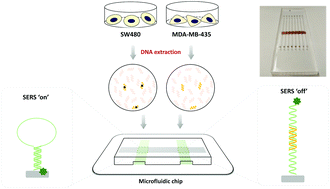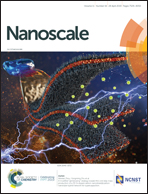Amplification-free SERS analysis of DNA mutation in cancer cells with single-base sensitivity†
Abstract
Accurate and sensitive identification of DNA mutations in tumor cells is critical to the diagnosis, prognosis and personalized therapy of cancer. Conventional polymerase chain reaction (PCR)-based methods are limited by the complicated amplification process. Herein, an amplification-free surface enhanced Raman spectroscopy (SERS) approach which directly detects point mutations in cancer cells has been proposed. A highly sensitive and uniform SERS substrate was fabricated using gold@silver core–shell nanorods, achieving an enhancement factor of 1.85 × 106. By combining the SERS-active nanosubstrate with molecular beacon probes, the limit of detection reached as low as 50 fM. To enable parallel analysis and automated operation, the SERS sensor was integrated into a microfluidic chip. This novel chip-based assay was able to differentiate between mutated and wild-type KRAS genes among a variety of other nucleic acids from cancer cells in 40 min. Owing to the simple operation and fast analysis, the SERS-based DNA assay chip could potentially provide insights into clinical cancer theranostics in an easy and inexpensive manner at the point of care.



 Please wait while we load your content...
Please wait while we load your content...